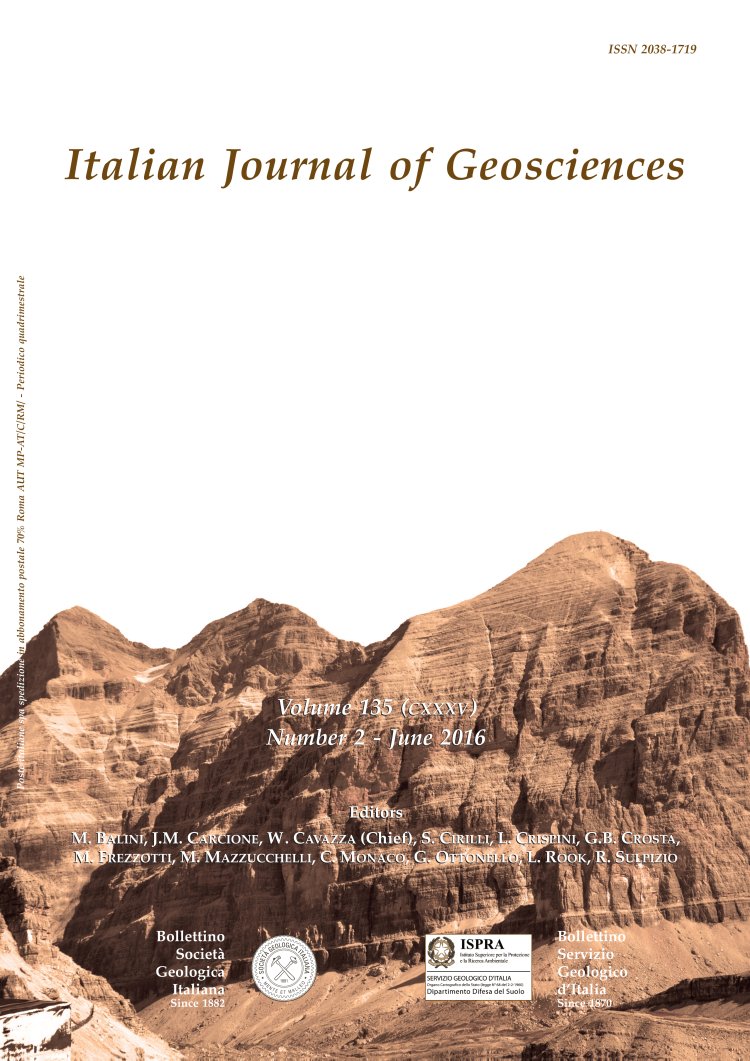
Permian-Cenozoic deep-water carbonate rocks of the Southern Tethyan Domain. The case of Central Sicily
Luca Basilone (*), Alfredo Frixa (**), Elena Trincianti (**) & Vera Valenti (*)
(*) Earth and Marine Sciences Dept., University of Palermo, Via Archirafi, 22 - 90123 Palermo (Italy). Corresponding author e-mail: luca.basilone@unipa.it
(**) Eni SpA Upstream and Technical Services, Via Emilia, 1 - 20097 San Donato Milanese (MI), Italy.
Volume: 135 (2016) f.2
Pages: 171-198
Abstract
We present an integrated stratigraphy of the outcropping and buried Permian-Cenozoic deep-water carbonate successions, forming some of the tectonic units mostly buried beneath the Late Neogene sedimentary cover in the fold and thrust belt of Central Sicily.
Three main successions, pertaining to the well known Lercara, Imerese and Sicanian domains, have been reconstructed on the basis of a detailed facies analysis, seismostratigraphic interpretation, biostratigraphy (mostly based on palynological data) and comparison between outcropping and subsurface deep-water sediments.
The main results reveal a continuous sedimentation of the deepwater Southern Tethyan Sicilian succession since the Permian to Cenozoic. In detail: a) the Permian-Middle Triassic terrigenous and carbonate deep-water successions, outcropping or buried in the Cerda, Lercara-Roccapalumba and Sosio Valley regions, are well comparable to each other and represent the common substrate of the Mesozoic-Paleogene Imerese and Sicanian carbonate successions; b) the Mesozoic-Paleogene deep-water carbonates, when compared among them, reveal the occurrence of different sedimentary successions (Imerese and Sicanian); c) the Oligo-Miocene foreland basin terrigenous sediments (Numidian flysch) clearly differ from the coeval foreland pelagic to open-shelf carbonates.
The paleogeographic reconstruction envisages: a) during the Permian-Triassic, a wide subsident continental rifting area, bordered by a shallow-water domain periodically supplying the basin with calciturbiditic to gravity flows sedimentation (rift stage of the Southern Tethyan margin); b) during the Jurassic-Paleogene, two different deep-water basins developed in a context of a post-rift stage. The different sedimentation reflects the location of the Imerese and Sicanian basins, respectively, along adjacent rimmed shelf and stepped carbonate platform margins.
Three main successions, pertaining to the well known Lercara, Imerese and Sicanian domains, have been reconstructed on the basis of a detailed facies analysis, seismostratigraphic interpretation, biostratigraphy (mostly based on palynological data) and comparison between outcropping and subsurface deep-water sediments.
The main results reveal a continuous sedimentation of the deepwater Southern Tethyan Sicilian succession since the Permian to Cenozoic. In detail: a) the Permian-Middle Triassic terrigenous and carbonate deep-water successions, outcropping or buried in the Cerda, Lercara-Roccapalumba and Sosio Valley regions, are well comparable to each other and represent the common substrate of the Mesozoic-Paleogene Imerese and Sicanian carbonate successions; b) the Mesozoic-Paleogene deep-water carbonates, when compared among them, reveal the occurrence of different sedimentary successions (Imerese and Sicanian); c) the Oligo-Miocene foreland basin terrigenous sediments (Numidian flysch) clearly differ from the coeval foreland pelagic to open-shelf carbonates.
The paleogeographic reconstruction envisages: a) during the Permian-Triassic, a wide subsident continental rifting area, bordered by a shallow-water domain periodically supplying the basin with calciturbiditic to gravity flows sedimentation (rift stage of the Southern Tethyan margin); b) during the Jurassic-Paleogene, two different deep-water basins developed in a context of a post-rift stage. The different sedimentation reflects the location of the Imerese and Sicanian basins, respectively, along adjacent rimmed shelf and stepped carbonate platform margins.
Keywords
Permian-Cenozoic stratigraphy, deep-water carbonates, surface and well-log data, seismic calibration, Central Sicily.
Get Full Text